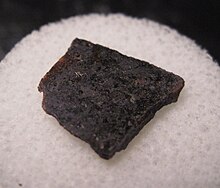Angrite
| Angrite | |
|---|---|
| — Stony meteorite | |
| Type | Achondrite |
| Subgroups | Quenched Plutonic |
3819 Robinson or Mercury | |
| Total known specimens | 30+ |

Angrites are a rare group of
Origin
Angrite meteorites are distinct from other meteoritic groups based on their oxygen isotopic compositions.[1] Based on their Mn-Fe ratios in pyroxene and other isotopic compositions, the source of angrites is constrained to the inner Solar System. However, recent studies have suggested that the APB experienced mixing of multiple sources during its history.[2]
By comparing the
Based on the lack of an asteroid matching the spectra of angrite meteorites it is thought that the APB was catastrophically disrupted and subsequently destroyed.
Notable meteorites
There are currently over 30 meteorites classified as angrites. The type specimen, the Angra dos Reis meteorite, was an observed fall in 1869 and weighed 1.5 kilograms (3.3 lb). Most of it has been lost over time; the largest remaining piece, weighing 101 grams, is kept at the Museum of Natural History in Rio de Janeiro.[4]
NWA 10463 has been suggested to represent an intermediate stage between the quenched and plutonic angrite meteorites. [5]
NWA 8535 has been suggested to represent a Dunite. [6]
Asuka-12209; Asuka-88371 and NWA 12320 demonstrate an oxygen isotopic disequilibrium indicative of planetary mixing. [2]
See also
External links
- D'Orbigny Angrite - Meteorites Australia
- Angrite Micro Visions - Thin section pictures of angrites.
References
- ^ Rider-Stokes, Ben (2021). "REVISING THE ANGRITE FRACTIONATION LINE: NEW INSIGHTS FROM HIGH-PRECISION OXYGEN ISOTOPE STUDIES" (PDF). Annual Meeting of the Meteoritics Society. 6071: 1.
- ^ a b Rider-Stokes, Ben (2022). "Mixing in the early Solar System as evidenced by the quenched angrite meteorites" (PDF). 53rd Lunar and Planetary Science Conference. 1420: 2.
- Bibcode:2005AGUFM.P51A0898I.
- ISBN 978-0521663038.
- Bibcode:2017LPICo1987.6313S.
- Bibcode:2015LPI....46.2681A.
